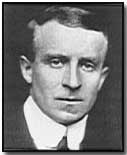Prose & Poetry - John Buchan
 John Buchan (1875-1940), statesman, publisher, journalist, biographer, poet
and novelist, was born on 26 August 1875 in Perth, Scotland.
John Buchan (1875-1940), statesman, publisher, journalist, biographer, poet
and novelist, was born on 26 August 1875 in Perth, Scotland.
Educated at Hutcheson's Grammar School and Glasgow University, Buchan had already begun his extensive publishing career by the time he won a scholarship to Brasenose College, Oxford, where he won the Newdigate Prize for poetry in 1898. During his time at Oxford Buchan, a workaholic, published five books and numerous articles, partly to raise funds in order to continue his studies.
Despite his training as a lawyer (a profession he would later assign to the fictional character he created most in his own mould, Sir Edward Leithen), Buchan travelled to South Africa in 1901 to become Lord Milner's private secretary (the High Commissioner) in the immediate aftermath of the Boer War.
Upon his return to England in 1903 he took up a position as a director of the publishing company, Thomas Nelson & Sons, with whom he continued a long relationship: Nelson published many of his works. Buchan's first novel, Sir Quixote of the Moors, was published in 1895.
Whilst recovering from illness in the early part of 1914 Buchan wrote his most famous work, The Thirty-Nine Steps, which was serialised in Blackwood's Magazine from July of that year. With its plot of German espionage it was highly topical and was an instant hit; never out of print it remains popular today, and has twice been produced for the cinema, including the 1935 Hitchcock version (whose plot revisions Buchan considered an improvement on his book).
With the outbreak of war Buchan was recruited by Charles Masterman, head of the War Propaganda Bureau, to write an ongoing history of the war in magazine form. Nelson's History of the War, in twenty four instalments, began to appear in February 1915. Given the pervading climate of the time, and Buchan's position, Buchan's history was slanted generally towards the view the government wished portrayed: his History of the War is consequently historically inaccurate. By nature Buchan was a promoter of the cause of empire.
In early 1915 Buchan became one of five journalists attached to the British Army, with responsibility for writing articles for both The Times and the Daily News. Consequently Buchan covered Second Ypres and the Battle of Loos.
Despite his government commitments, Buchan continued to write novels during the war, with Greenmantle a highly popular sequel to The Thirty-Nine Steps in 1915. In February 1917 Buchan was given charge of the newly formed Department of Information.
With the war over Buchan continued to write novels, as well as biographies (Montrose (1928), Sir Walter Scott (1932) among others) and histories (he wrote the official war history of the South African brigade). An active man, he held many positions, becoming a director of the news agency Reuters, and in 1927 was elected Conservative MP for the Scottish Universities, holding the seat until he became Baron Tweedsmuir in 1935.
That same year Buchan was made Governor-General of Canada, a position he held (and in which he was highly regarded) until his death in Montreal on 11 February 1940. Married in 1907 to Susan Grosvenor, Buchan suffered from ill-health - chiefly a duodenal ulcer - for much of his life. His autobiography, Memory Hold the Door, was published posthumously in 1940.
Download "The 39 Steps" (Project Gutenberg Text)
Download "Greenmantle" (Project Gutenberg Text)
Download "Mr Standfast" (Project Gutenberg Text)
"Beachy Bill" was the name given to one of the Turkish guns which regularly shelled Anzac Cove.
- Did you know?
